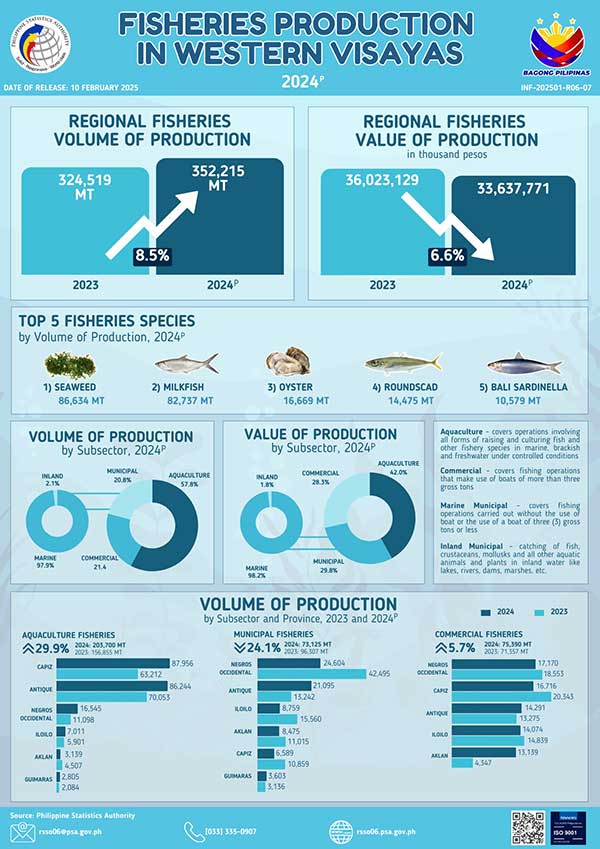
By Francis Allan L. Angelo
Fisheries production in Western Visayas grew by 8.5% in 2024, contrasting the 5% national decline, which marked the lowest fisheries output in two decades.
According to the Philippine Statistics Authority (PSA), the region recorded 352,215 metric tons of fisheries production in 2024, up from 324,519 metric tons in 2023.
The growth was primarily driven by aquaculture, which surged 29.9% to 203,700 metric tons.
Capiz and Antique led the region’s aquaculture production, contributing 43.2% and 42.3% of the total, respectively. Negros Occidental, Iloilo, and Guimaras also posted increases, while Aklan was the only province to record a 30.4% decline.
Commercial fisheries also posted moderate growth, rising 5.7% from 71,357 metric tons in 2023 to 75,390 metric tons in 2024.
Aklan recorded the highest increase at 202.3%, followed by Antique at 7.6%. However, declines were noted in Capiz (-17.8%), Negros Occidental (-7.5%), and Iloilo (-5.2%).
Municipal Fisheries Continue to Decline
Despite overall growth, municipal fisheries struggled, declining 24.1% in 2024. Marine municipal fisheries, which make up the bulk of this sector, dropped 23.4%, while inland fisheries plummeted 47.1%.
The hardest-hit provinces were Iloilo (-44.0%), Negros Occidental (-42.3%), and Capiz (-37.9%). Only Antique (+59.8%) and Guimaras (+15.4%) posted increases.
The decline mirrors a nationwide trend, raising concerns about the sustainability of small-scale fishing operations.
Marine conservation group Oceana cited overfishing, illegal commercial fishing in municipal waters, and environmental degradation as key factors affecting municipal fisheries. (See sidebar story)
Economic Impact and Value of Production
The region’s fisheries sector generated PHP 33.64 billion in 2024, a 6.6% drop from PHP 36.02 billion in 2023. The decline was primarily due to municipal fisheries, which lost 30.7% of total value.
Aquaculture remained the most valuable sector, growing 12.9% and accounting for 42% of total fisheries value. Commercial fisheries also saw a 4.7% increase, while marine and inland municipal fisheries recorded losses of 30.3% and 47.0%, respectively.
The drop in municipal fisheries’ value underscores the challenges faced by small-scale fishers, who struggle with competition from commercial operators, environmental degradation, and climate change-related disruptions.
Fourth Quarter 2024 Highlights
Western Visayas’ total fisheries production in Q4 2024 reached 91,489 metric tons, up 33.3% from the previous year, driven by a surge in aquaculture.
- Aquaculture Growth: Increased 90.5%, making up 65.1% of the region’s total fisheries output. Capiz led with a 184.4% increase (46.2% share), followed by Antique (+64.7%, 41.5% share).
- Municipal Fisheries Decline: Fell 28.3%. Marine municipal fisheries dropped 28.0%, with declines in Negros Occidental, Iloilo, and Capiz, while Antique, Aklan, and Guimaras posted increases. Inland municipal fisheries fell 35.8%.
- Commercial Fisheries Growth: Increased 5.4%, driven by Aklan and Antique, while Capiz, Negros Occidental, and Iloilo recorded declines.
- Increase in Production Value: Total fisheries value rose 11.2% to PHP 8.98 billion.
- Aquaculture accounted for 51.2% of total value (+70.1%).
- Commercial fisheries made up 24.1% (+7.8%).
- Municipal fisheries held a 24.6% share but saw a 34.1% decline in value.
- Marine municipal fisheries value dropped 33.8%, while inland fisheries fell 44.9%.
Key Takeaways
Western Visayas’ fisheries industry remains resilient amid national declines, largely due to strong aquaculture growth. However, the persistent decline in municipal fisheries signals an urgent need for policy intervention, stricter enforcement of fisheries laws, and support for small-scale fishers to ensure long-term sustainability.






















